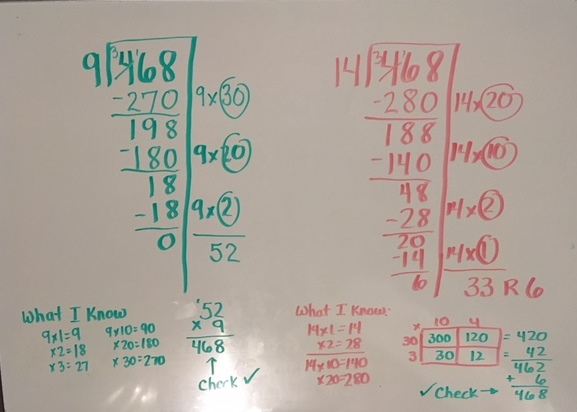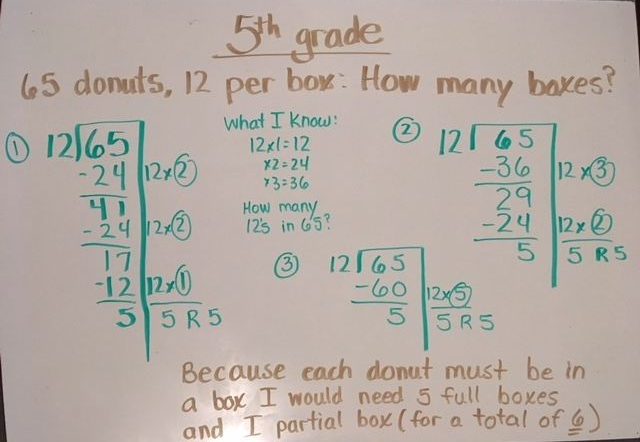by C. Elkins, OK Math and Reading Lady
Is division a dreaded topic on your list of objectives to teach? Like many math topics, students have a harder time understanding it most likely because it’s not something they use regularly in their lives. Students should understand why division is useful before they have to start solving division problems. In this post, I will focus on helping students see the relationship between subtraction, multiplication, and division both with concrete objects, pictures, and the partial quotients model. Freebies available below!!
- 425 divided by 8 picture form
- 425 divided by 8 partial quotients model
Then let’s talk about what division really is — it is repeated subtraction; much the way multiplication is repeated addition. The issue is that repeated subtraction is not always very efficient. Here’s what I mean.
Let’s say I have the basic problem 25 ÷ 5. I could start with 25 and then subtract 5, subtract another 5, another 5, another 5, and another 5 until I run out and reach zero. I would have to do this 5 times. If I had 25 cookies that I wanted to share equally among 5 friends, I could do the “one for you, one for you, one for you, one for you, and one for you” process and still end up with 5 cookies for each. Or I could try “two for you, two for you,” etc. to make the action of passing out the cookies faster. When I get down to 5 cookies, I return to the “one for you . . .” to make it work.
With a larger problem such as 72 ÷ 6, I can again try subtracting 6 at a time until I reach zero. This would take 12 repetitions — not efficient, but still accurate. Could I subtract 12 at a time instead (2 groups of 6) to be more efficient? Or 18 at a time, or 24 at at time? This is the idea behind the partial quotients model I will refer to a little later.
But what about 375 ÷ 50? If I don’t know how to divide by double digit numbers, the repeated subtraction process might actually be a good choice . . . at least showing some number sense to know that 375 divided by 50 means “How many 50’s in 375?” I know if I subtract 50 six times, I still have 75 left. I can subtract another 50 and I have 25 left over. So 375 ÷ 50 = 7 with a remainder of 25.
Even first graders in OK have an objective to “partition (fair share) sets of objects into equal groupings.” They have the task of taking a small number of objects and dividing them up so they are in equal groups – using manipulatives and drawings. I would fully expect first graders to utilize the “one for you, one for you . . .” process — repeated subtraction.
I recently worked with 2 classes (4th and 5th grade) to introduce the partial quotients model. Fourth graders worked with 2-3 digit dividends and 1 digit divisors (with no remainders), while fifth graders worked with 2-5 digit dividends and 1-2 digit divisors. Here’s my approach:
- I asked, “What do you already know about division?” They seemed to understand the concept of equal groups. Fifth graders typically recalled the standard algorithm with knowledge that subtraction and multiplication were involved. There was no mention of repeated subtraction or much beyond the typical long division steps.
- I asked, “Why do we need or how do we use division in our lives?” Most had limited conversation about this and related it to money or dividing up a candy bar. I told a true story of one way we used division in our house: Very often when I bought a package of cookies, they were all gone in a matter of 1-2 days, leaving hardly any for me or my husband. So our solution was to divide the cookies into 4 baggies (husband, me, son #1, son #2) with an even amount in each baggie. Once you ate your fair share, that was it. We didn’t actually have to do this forever – just until the boys learned not to take more than their fair share out of the package and leave some for the rest of the family. But it was a good (true) story for the students to hear how division was actually utilized in real life. Here are some more ideas we discussed:
- Sharing fairly (money, candy, toys, cookies, etc.)
- Packaging items (socks, gum, crackers, crayons, donuts)
- Averages (points after several games, miles traveled after several hours, amount of money earned over time)
- Problem solving (vehicles needed to take a large #of people, boxes needed to ship several items, trays needed to bake cookies)
- Next, I wanted them to see how division is really just repeated subtraction, and showed a couple examples like above. Students got the idea quickly that this would take a lot of time to keep subtracting the same number over and over again. But we started to look at how we could subtract larger chunks (again, leading to the understanding behind partial quotients).
- I gave each class a task to simulate the division process. They took on the role of workers at a bakery. They had to package donuts according to the specifics of the problem. The donuts were small colorful cubes (I told them these were donuts with sprinkles). The boxes for the donuts were tan pieces of construction paper. To further simulate the conditions I told them they could not eat the donuts and to be careful not to let the donuts fall on the floor! Also, they had to be efficient and cooperative or they would get fired.
Fourth Grade:
Students worked with a partner to divide 60 donuts equally into 5 boxes. They needed to be able to tell me how they went about putting the donuts into the boxes (but it couldn’t be 1 at a time). And . . . I didn’t want the donuts thrown into the boxes. They needed to be arranged so that any supervisor checking on them (the teachers) could readily tell how many donuts were in the box. If they are just randomly arranged, it is too hard to tell at a glance how many there are. This helped students gain more practice using equal groups to make the division process more efficient.
- 12 donuts arranged in 4s
- 12 donuts arranged in 6s
Students went about taking their 60 donuts and dividing them among the 5 boxes. Some started with 4 at a time, 5 at a time, 6 at a time, or 10 at a time (again I will relate this to the partial quotient model).
Fifth Grade:
Students worked with a partner to divide 65 donuts equally into ? number of boxes. This time, I specified I wanted 12 donuts in each box. If there were less than 12, I still wanted them in a box. Their job was to determine how many boxes would be needed to box these 65 donuts. I gave them 3 “boxes” to start with. If they needed more, they had to get them from the storeroom (teacher table). This way they had to determine each time they needed another box. I chose this problem because it is a common dilemma with problem solving. If I solve it mathematically, I get 5 with a remainder of 5 – but with this problem the answer would actually be 6 because every donut needs to be in a box. There will be 5 full boxes and 1 box partially filled with 5 donuts.  Again, I reminded them that donuts need to be arranged neatly in their boxes so the supervisors could check that there were 12 donuts in each filled box. A small number of students were holding their extra 5 donuts wondering what to do with them. All I had to do was ask, “Are you going to just hand the customer the extra donuts and expect them to hold them in their hands?” No – every donut must be in a box.
Again, I reminded them that donuts need to be arranged neatly in their boxes so the supervisors could check that there were 12 donuts in each filled box. A small number of students were holding their extra 5 donuts wondering what to do with them. All I had to do was ask, “Are you going to just hand the customer the extra donuts and expect them to hold them in their hands?” No – every donut must be in a box.
Now here is how we related the above problems mathematically to the partial quotients model.
- 3 options for 4th gr. problem
- 3 options for 5th gr. problem
The partial quotients model allows students do solve a long division problem in smaller known chunks. I believe this is a helpful model, especially when students do not know all of their related multiplication facts. They can use the facts they know to subtract a little at a time. The student who knows their facts (yeah!!) will be able to solve the problem in less steps. The student who struggles some, should still be able to solve – it will just take more steps. If you google or look on youtube, you will see several different versions. I happen to prefer the version where students list a few of the facts they know before proceeding, write the multiplication fact used on the side, circle the partial quotients, and then total them to find the complete quotient. Take time to work through examples with students, and by all means show them different paths to the same problem. Another tip: Use story problems (either verbal or written) with each problem so students hear good examples of what division is all about.
Here are 2 other problems with larger numbers. For a FREE TUTORIAL, click here: Partial quotients tutorial. I have provided step by step instructions and thought processes with numerous examples. Another FREEBIE: “What I Know” chart . This is a resource chart for multiplication facts (x1, x2, x3 . . . x 10, x 20, x30 . . .) to help when doing partial quotients problems. The first page is blank for students to complete. The second is for teachers because it has the answers.
Enjoy!
C. Elkins, OK Math and Reading Lady







